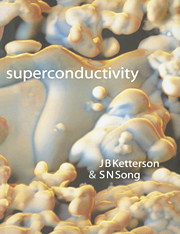Book contents
- Frontmatter
- Contents
- Preface
- Part I Phenomenologlcal theories of superconductivity
- 1 Introduction
- 2 The London–London equation
- 3 Pippard's equation
- 4 Thermodynamics of a Type I superconductor
- 5 The intermediate state
- 6 Surface energy between a normal and a superconducting metal
- 7 Quantized vorticity
- 8 Type II superconductivity
- 9 The Ginzburg–Landau theory
- 10 The upper critical field of a Type II superconductor
- 11 The anisotropic superconductor
- 12 Thin superconducting slabs
- 13 Surface superconductivity
- 14 The Type II superconductor for H just below Hc2
- 15 The Josephson effects
- 16 The Josephson lattice in ID
- 17 Vortex structure in layered superconductors
- 18 Granular superconductors: the Josephson lattice in 2D and 3D
- 19 Wave propagation in Josephson junctions, superlattices, and arrays
- 20 Flux pinning and flux motion
- 21 Time-dependent G–L theory
- 22 Fluctuation effects
- 23 G–L theory of an unconventional superfluid
- 24 Landau Fermi liquid theory
- Part II The microscopic theory of a uniform superconductor
- Part III Nonuniform superconductivity
- Appendix A Identical particles and spin: the occupation number representation
- Appendix B Some calculations involving the BCS wavefunction
- Appendix C The gap as a perturbation through third order
- Superconducting transition temperature, thermodynamic critical field, Debye temperature and specific heat coefficient for the elements
- References
- Additional reading
- List of mathematical and physical symbols
- Index
24 - Landau Fermi liquid theory
Published online by Cambridge University Press: 05 June 2012
- Frontmatter
- Contents
- Preface
- Part I Phenomenologlcal theories of superconductivity
- 1 Introduction
- 2 The London–London equation
- 3 Pippard's equation
- 4 Thermodynamics of a Type I superconductor
- 5 The intermediate state
- 6 Surface energy between a normal and a superconducting metal
- 7 Quantized vorticity
- 8 Type II superconductivity
- 9 The Ginzburg–Landau theory
- 10 The upper critical field of a Type II superconductor
- 11 The anisotropic superconductor
- 12 Thin superconducting slabs
- 13 Surface superconductivity
- 14 The Type II superconductor for H just below Hc2
- 15 The Josephson effects
- 16 The Josephson lattice in ID
- 17 Vortex structure in layered superconductors
- 18 Granular superconductors: the Josephson lattice in 2D and 3D
- 19 Wave propagation in Josephson junctions, superlattices, and arrays
- 20 Flux pinning and flux motion
- 21 Time-dependent G–L theory
- 22 Fluctuation effects
- 23 G–L theory of an unconventional superfluid
- 24 Landau Fermi liquid theory
- Part II The microscopic theory of a uniform superconductor
- Part III Nonuniform superconductivity
- Appendix A Identical particles and spin: the occupation number representation
- Appendix B Some calculations involving the BCS wavefunction
- Appendix C The gap as a perturbation through third order
- Superconducting transition temperature, thermodynamic critical field, Debye temperature and specific heat coefficient for the elements
- References
- Additional reading
- List of mathematical and physical symbols
- Index
Summary
The Pauli–Sommerfeld free electron model of a metal is remarkably successful in describing many of the properties of metals such as the linear behavior of the specific heat (C = γT) and the temperature-independent paramagnetic susceptibility. However, the energy associated with the Coulomb repulsion between electrons is of the same order as the kinetic energy and it is therefore not at all obvious that such a model should work at all.
Liquid He (at temperatures below 0.1 K) is another Fermi system which has some features in common with a Fermi gas. (He has no electronic spin and its statistics are governed by its I = 1/2 nuclear spin.) It may be thought of as having an even larger particle–particle interaction since the ‘empty volume’ for the atoms to move in is small; most of the liquid volume is occupied by the essentially impenetrable ‘hard core’ associated with the filled Is shell of the He atoms.
The long range of the Coulomb potential adds an initially unnecessary feature to understanding the success of the independent (or free) electron model so we will use (neutral) liquid He as our model Fermi ‘liquid’.
The success of the Pauli–Sommerfeld model rests on there being a sharp discontinuity separating the occupied from the unoccupied states at T = 0 which is associated with the Fermi occupation factor, n(ε).
- Type
- Chapter
- Information
- Superconductivity , pp. 180 - 194Publisher: Cambridge University PressPrint publication year: 1999



